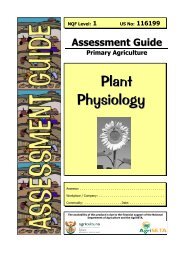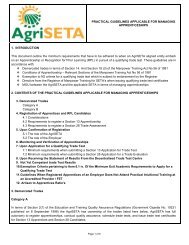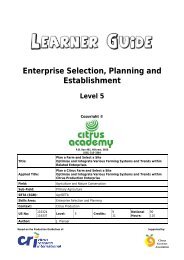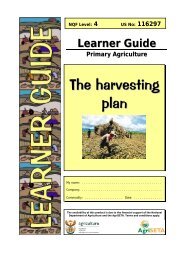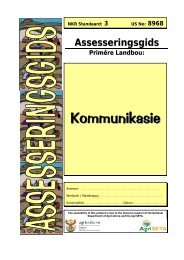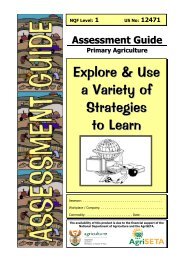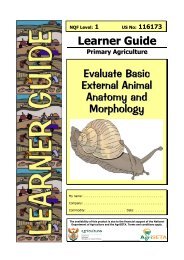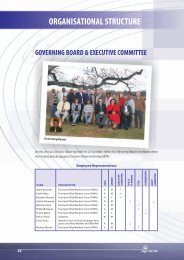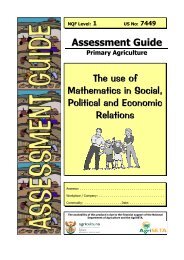Learner Guide - AgriSETA
Learner Guide - AgriSETA
Learner Guide - AgriSETA
You also want an ePaper? Increase the reach of your titles
YUMPU automatically turns print PDFs into web optimized ePapers that Google loves.
Harvesting<br />
Level 3<br />
Copyright ©<br />
P.O. Box 461, Hillcrest, 3650<br />
(031) 313-3364<br />
Title:<br />
Monitor and Coordinate the Harvesting of Agricultural Crops<br />
Applied Title:<br />
Monitor and Coordinate the Harvesting of Citrus<br />
Field:<br />
Agriculture and Nature Conservation<br />
Sub-Field:<br />
Primary Agriculture<br />
SETA (SGB):<br />
<strong>AgriSETA</strong><br />
Skills Area:<br />
Harvesting<br />
Context:<br />
Citrus Production<br />
US No: 116268 Level: 3 Credits: 4<br />
Author:<br />
Mooipraatjies<br />
Notional<br />
Hours:<br />
40<br />
Based on the Production <strong>Guide</strong>lines of:<br />
Supported by:<br />
Citrus<br />
Growers<br />
Association
Assessment <strong>Guide</strong> – Assessor and Facilitator<br />
Skills Area: Harvesting<br />
Level: 3<br />
Unit Standard: 116268<br />
Table of Contents<br />
Directions ............................................................................................................................................. 3<br />
Step 1 .................................................................................................................................................. 4<br />
Step 2 .................................................................................................................................................. 5<br />
Step 3 .................................................................................................................................................. 6<br />
Step 4 .................................................................................................................................................. 7<br />
Step 5 .................................................................................................................................................. 8<br />
Step 6 ................................................................................................................................................ 15<br />
Step 7 ................................................................................................................................................ 17<br />
Step 8 ................................................................................................................................................ 20<br />
Step 9 ................................................................................................................................................ 21<br />
Step 10 .............................................................................................................................................. 27<br />
2<br />
Citrus<br />
Growers<br />
Association
Assessment <strong>Guide</strong> – Assessor and Facilitator<br />
Skills Area: Harvesting<br />
Level: 3<br />
Unit Standard: 116268<br />
Directions<br />
Please Note: There is a separate assessment guide for the learner. The learner must use this guide to<br />
prepare himself / herself for the assessment.<br />
This assessment guide contains all necessary activities and instructions that will enable the assessor and<br />
learner to gather evidence of the learner’s competence as required by the unit standard. This guide was<br />
designed to be used by a trained and accredited assessor who is registered to assess this specific unit<br />
standard as per the requirements of the <strong>AgriSETA</strong> ETQA.<br />
Prior to the delivery of the program the facilitator and assessor must familiarise themselves with content of<br />
this guide, as well as the content of the assessment guide for learners.<br />
The assessor, facilitator and learner must plan the assessment process together, in order to offer the learner<br />
the maximum support, and the opportunity to reflect competence.<br />
The policies and procedures that are applicable during the execution of this assessment are available on the<br />
website of the Citrus Academy, contained in a document named Policies and Procedures for Assessment, and<br />
must be strictly adhered to. The assessor must familiarise himself with this document before proceeding.<br />
This guide provides step-by-step instructions for the assessment process of:<br />
US No: 116268 Level: 3 Credits: 4<br />
The step-by-step instructions agree and are conducted in concert with the steps described in the learner<br />
assessment guide. The steps are as follows:<br />
Step Description Timeframe<br />
1 Pre-Assessment Briefing and Checklist Before delivery of program<br />
2 <strong>Learner</strong> Declaration of Authenticity Before delivery of program<br />
3 Diagnostic Assessment of Learning Assumed to be in Place Before delivery of program<br />
4 Assessment Plan for Gathering of Evidence Before delivery of program<br />
5 <strong>Learner</strong> Formative Assessment Activities<br />
During delivery of program, assessment<br />
after delivery of program<br />
6 Summative Assessment After delivery of program<br />
7 Integrated Summative Assessment Tool After delivery of program<br />
8 Re-assessment Procedures After completion of assessment<br />
9 Documentation After completion of assessment<br />
10 Administration and Completion of Portfolio of Evidence After completion of assessment<br />
3<br />
Citrus<br />
Growers<br />
Association
Assessment <strong>Guide</strong> – Assessor and Facilitator<br />
Skills Area: Harvesting<br />
Level: 3<br />
Unit Standard: 116268<br />
Step 1<br />
Pre-Assessment Briefing and Checklist<br />
A pre-assessment briefing for learners is held before the delivery of the program. Use the checklist below to<br />
ensure that all these points are addressed and discussed with the learners.<br />
Organise resources – people, equipment, venue, etc.<br />
Explain the purpose of the assessment<br />
Discuss the standards or criteria to be used<br />
Discuss assessment roles and accountabilities<br />
Decide on assessment venues<br />
Pre-Assessment Briefing Checklist<br />
Negotiate evidence required, and where or how this evidence may be gathered<br />
Explain the methods of assessment that will be used during the gathering and summing up<br />
of evidence<br />
Negotiate the date of submission for the activity workbook and the date for the summative<br />
assessment<br />
Discuss resources required for the assessment e.g. equipment, materials, etc.<br />
Explain the procedure if the learner is found to be not yet competent<br />
Explain the appeal and review procedures<br />
Identify any potential learning barriers and negotiate strategies to overcome these<br />
Complete and sign the assessment plan with the learner<br />
√<br />
Χ<br />
The learner and assessor must sign the <strong>Learner</strong> Contract in the learner assessment guide.<br />
4<br />
Citrus<br />
Growers<br />
Association
Assessment <strong>Guide</strong> – Assessor and Facilitator<br />
Skills Area: Harvesting<br />
Level: 3<br />
Unit Standard: 116268<br />
Step 2<br />
<strong>Learner</strong> Declaration of Authenticity<br />
The learner is requested to complete and sign the Declaration of Authenticity in the learner assessment<br />
guide. This should be checked and co-signed by the assessor.<br />
The format is as reflected in the learner assessment guide.<br />
5<br />
Citrus<br />
Growers<br />
Association
Assessment <strong>Guide</strong> – Assessor and Facilitator<br />
Skills Area: Harvesting<br />
Level: 3<br />
Unit Standard: 116268<br />
Step 3<br />
Diagnostic Assessment of Learning Assumed to be in Place<br />
In the learner assessment guide, the learner is asked to indicate whether they have completed the learning<br />
assumed to be in place as prescribed by the unit standard.<br />
The assessor must guide the learners through this step, explaining in detail the content of the mentioned<br />
learning areas, because names of learning programs do not always agree with the names of the unit<br />
standards, and learners might indicate the incorrect information.<br />
If learners indicate that they have not yet completed the mentioned unit standards, the assessor should<br />
prescribe an action plan to allow the learner to obtain the skills required by recommending additional<br />
training, competence portfolios, or the relevant RPL assessment for the given unit standards.<br />
The format is as reflected in the assessment guide for learners. Please read it and familiarise yourself with<br />
its content.<br />
6<br />
Citrus<br />
Growers<br />
Association
Assessment <strong>Guide</strong> – Assessor and Facilitator<br />
Skills Area: Harvesting<br />
Level: 3<br />
Unit Standard: 116268<br />
Step 4<br />
Assessment Plan for Gathering of Evidence<br />
A pro-forma assessment plan for this unit standard has been drafted in the learner assessment guide.<br />
Explain the plan to the learner and complete the dates and signatures as indicated.<br />
The format for the assessment plan is as reflected in the assessment guide for learners. Please read it and<br />
familiarise yourself with its content. Make a note of the dates agreed upon in the table provided below.<br />
Unit Standard<br />
Registration<br />
Number<br />
Step<br />
<strong>Learner</strong> and Assessor Assessment Plan<br />
Harvest Citrus: Procedures<br />
116268<br />
Description<br />
Completion /<br />
Submission<br />
Date<br />
Step 5<br />
<strong>Learner</strong> Formative Assessment Activities<br />
Step 6<br />
Summative Assessment<br />
Step 7<br />
Integrated Summative Assessment Tool<br />
Step 8<br />
Re-Assessment Procedures<br />
Step 9<br />
Documentation<br />
Step 10<br />
Administration and Completion of Portfolio of Evidence<br />
7<br />
Citrus<br />
Growers<br />
Association
Assessment <strong>Guide</strong> – Assessor and Facilitator<br />
Skills Area: Harvesting<br />
Level: 3<br />
Unit Standard: 116268<br />
Step 5<br />
<strong>Learner</strong> Formative Assessment Activities<br />
The <strong>Learner</strong> Assessment <strong>Guide</strong> contains comprehensive activities and worksheets that the learner must<br />
complete during the delivery of the learning program. It is imperative that these activities be completed as<br />
part of the learning process in order to give the learner the opportunity to develop the skills, knowledge and<br />
attitudes that are required for competence.<br />
<strong>Learner</strong>s must complete all the activities in the workbook.<br />
<strong>Learner</strong>s must be encouraged to take control of their learning by indicating areas in the workbook where<br />
they experience difficulty.<br />
<strong>Learner</strong>s hand in the <strong>Learner</strong> Assessment <strong>Guide</strong> to the assessor or the facilitator, only if the facilitator is a<br />
subject matter expert, for the assessment of the formative assessment activities. The assessment of these<br />
activities must be done according to the prescribed benchmarks and according to the marking matrix that<br />
follows.<br />
The learner must not move on to the next step before this step has been completed and learners show<br />
sufficient capacity and readiness for summative assessment. If problems areas are identified, the learner<br />
should be guided with a developmental action plan, which is documented separately and signed by the<br />
learner, the facilitator and the assessor.<br />
Model answers are provided below.<br />
Activity 1 – Presentation<br />
Give an educational presentation aimed at a new farm worker, concerning the following. Attach a copy and<br />
other details of your presentation to your learner workbook.<br />
• What are the tools required to harvest the citrus on the farm where you work<br />
• Demonstrate how to use these tools accurately.<br />
• What must a worker do if there is a problem with the tools<br />
• Choose one harvesting tool and explain the maintenance and care of this tool.<br />
• Explain what must happen if there is a problem with this tool.<br />
Presentation must include the following:<br />
• Tools must include but are not limited to clippers, gloves, picking bags and ladders<br />
• Gloves (when used) – Inspect glove for holes pr tears, place glove on non dominant hand,<br />
only handle fruit with gloved hand<br />
• Clippers – Use finger loop correctly, place clipper at right angle to fruit, clip stem as close as<br />
possible to fruit<br />
• Picking bags – Two types of bags, bag over shoulder on same side as hand handling fruit,<br />
inspect bag for holes or tears, place and don’t throw fruit in bag, empty bag carefully into<br />
picking bin by allowing fruit to roll out(method may differ depending on the type of bag<br />
used)<br />
• Ladders – Ladders can have two or three legs, inspect for loose pieces and sturdiness, place<br />
ladder so that it does not damage fruit or tree and is stable<br />
Activity 2 – Worksheet<br />
Answer the questions below in your own words.<br />
8<br />
Citrus<br />
Growers<br />
Association
Assessment <strong>Guide</strong> – Assessor and Facilitator<br />
Skills Area: Harvesting<br />
Level: 3<br />
Unit Standard: 116268<br />
1. How do you as farm worker know that the fruit is ready for harvesting<br />
You will be instructed by your team leader / supervisor / manager about when to start<br />
picking. Farm management knows when the fruit is ready by taking samples from about 6<br />
weeks before the harvest should start, testing the samples and plotting the information on a<br />
graph, on which they can see when the fruit should reach maturity.<br />
2. How is fruit sampled to determine its maturity<br />
Index trees are selected, 12 fruit is picked per tree, samples are marked to indicate when and<br />
where the fruit was picked<br />
3. What is measured to determine fruit maturity<br />
Juice content, sugar level, and acid level are measured, ratio between sugar and acid is<br />
calculated, fruit colour is assessed<br />
Activity 3 – Group Discussion<br />
Discuss the following questions in your group. Make keynotes on your discussions and the conclusions that<br />
you reach.<br />
1. What are the factors that can influence the harvesting of the citrus<br />
Fruit maturity, available daylight hours, climatic conditions, market conditions<br />
2. Why would a citrus farm have a harvest plan<br />
To ensure a smooth and efficient harvesting operation, that fruit is picked at the right stage of<br />
maturity in the right manner, that labour and tools and equipment are available at the right<br />
time<br />
3. What are the special requirements for harvesting of citrus<br />
Must be done during daylight hours, temperature must be between 13 and 30 degrees<br />
centigrade, relative humidity must be below 70%, fruit must be dry, lemons cannot be<br />
harvested within two days after a cold front<br />
4. How is quality of citrus affected by the harvesting process<br />
Fruit can be damaged, injured and infected if not picked and handled in the correct manner<br />
Activity 4 – Workplace Research<br />
Obtain a copy of health and safety plan of the farm where you work and answer the questions below based<br />
on the information contained in it.<br />
1. Explain in your own words what is required from you during harvesting to protect your own health and<br />
safety and that of the product.<br />
Complete model answers not provided due to workplace variation, but should include:<br />
• Awareness of dangers posed by tools, equipment, machinery and vehicles<br />
• Personal hygiene (hand washing, short nails, clean clothing)<br />
• Sanitising hands after using ablution facilities<br />
• Careful handling of fruit to prevent injuries, damage and infection<br />
2. How does the health and safety plan link with OHSA<br />
Based on OHSA principles, e.g. employers must ensure worker safety, workers must not<br />
endanger their safety<br />
3. How does the health and safety plan link with GlobalGAP<br />
Complete model answers not provided due to workplace variation, but should include e.g.:<br />
• Availability and positioning of ablution facilities<br />
• Regulation of tools and equipment sterilisation<br />
9<br />
Citrus<br />
Growers<br />
Association
Assessment <strong>Guide</strong> – Assessor and Facilitator<br />
Skills Area: Harvesting<br />
Level: 3<br />
Unit Standard: 116268<br />
• Availability of protective clothing where required<br />
4. What are the exact procedures you will follow if someone falls off a ladder in the orchard during<br />
harvesting and the person lies there saying they are unable to move<br />
Complete model answers not provided due to variation in workplace SOPs, but should include:<br />
• Inform picking team supervisor<br />
• Emergency first aid procedures as per standard operating procedures applied by trained<br />
person<br />
5. What are the exact procedures that you will follow if a veld fire spreads to the orchard in which you are<br />
harvesting from an adjacent open field<br />
Complete model answers not provided due to variation in workplace SOPs, but should include:<br />
• Inform picking team supervisor<br />
• Evacuate orchard to predetermined assembly points<br />
• Follow instructions of health and safety officer<br />
Activity 5 – Workplace Observation Report<br />
Find answers to the questions below in your workplace.<br />
1. What are the wastes produced by the harvest process on the farm where you work<br />
Complete model answers not provided due to workplace variation, but should include e.g.:<br />
• Plant material (branches, leaves and fruit)<br />
• Paper, glass and plastic dropped by workers<br />
2. Why must the harvest area be kept clean<br />
Reasons given should include but are not limited to:<br />
• Limiting the spread of diseases<br />
• Preventing pest insects from propagating in fallen fruit<br />
• Avoiding pollution of natural resources<br />
• Fulfilling legal obligations<br />
3. Why are records kept of waste disposal<br />
Reasons given should include but are not limited to:<br />
• It is a legal requirement<br />
• To measure effectiveness of waste removal<br />
• To determine cost of waste removal<br />
10<br />
Citrus<br />
Growers<br />
Association
Assessment <strong>Guide</strong> – Assessor and Facilitator<br />
Skills Area: Harvesting<br />
Level: 3<br />
Unit Standard: 116268<br />
Specific Outcome 1: Select<br />
harvesting equipment and tools for<br />
specific agricultural enterprise.<br />
Marking Matrix and Assessor Report for Formative Assessment Activities<br />
Formative Evidence Collection Summary for Unit Standard 116268 – Level 3<br />
Action Required<br />
from <strong>Learner</strong> to<br />
Develop<br />
Competence<br />
Attend classroom<br />
lesson, participate and<br />
ask questions<br />
Competence<br />
Assessments<br />
Activities in learner<br />
activity book were<br />
completed correctly<br />
Standard for<br />
Activity<br />
Activity answers must<br />
be at least 85%<br />
correct<br />
Allocation of Marks<br />
As per model answer<br />
sheet<br />
Feedback to <strong>Learner</strong><br />
and Comments on<br />
Evidence<br />
Range: Harvesting methods according to<br />
specific production context include, but<br />
are not limited to harvesting by hand,<br />
machine harvesting, etc. Tools or<br />
equipment include but are not limited to<br />
picking shears, knives, mechanical<br />
harvesters, etc.<br />
Specific Outcome 2: Demonstrate<br />
an understanding of sampling for<br />
maturity indexing.<br />
Attend classroom<br />
lesson, participate and<br />
ask questions<br />
Activities in learner<br />
activity book were<br />
completed correctly<br />
Activity answers must<br />
be at least 85%<br />
correct<br />
As per model answer<br />
sheet<br />
Range: Maturity indexing may include,<br />
but is not limited to stage of growth of<br />
crop, sugar levels, size, colour, texture,<br />
ratios of one chemical versus another,<br />
level of ethylene production, etc.<br />
Specific Outcome 3: Demonstrate<br />
an understanding of the harvesting<br />
of crops according to harvesting<br />
plan.<br />
Attend classroom<br />
lesson, participate and<br />
ask questions<br />
Activities in learner<br />
activity book were<br />
completed correctly<br />
Activity answers must<br />
be at least 85%<br />
correct<br />
As per model answer<br />
sheet<br />
Range: Procedures include, but are not<br />
limited to quality specifications, maturity<br />
specifications, weather data, withholding<br />
periods, etc.<br />
11<br />
Citrus<br />
Growers<br />
Association
Assessment <strong>Guide</strong> – Assessor and Facilitator<br />
Skills Area: Harvesting<br />
Level: 3<br />
Unit Standard: 116268<br />
Specific Outcome 4: Implement a<br />
health, hygiene and safety plan<br />
during harvesting.<br />
Marking Matrix and Assessor Report for Formative Assessment Activities<br />
Formative Evidence Collection Summary for Unit Standard 116268 – Level 3<br />
Action Required<br />
from <strong>Learner</strong> to<br />
Develop<br />
Competence<br />
Attend classroom<br />
lesson, participate and<br />
ask questions<br />
Competence<br />
Assessments<br />
Activities in learner<br />
activity book were<br />
completed correctly<br />
Standard for<br />
Activity<br />
Activity answers must<br />
be at least 85%<br />
correct<br />
Allocation of Marks<br />
As per model answer<br />
sheet<br />
Feedback to <strong>Learner</strong><br />
and Comments on<br />
Evidence<br />
Range: Health, hygiene and safety plan<br />
includes but is not limited to ensuring<br />
that one worker has basic first aid skills<br />
per group harvesting, that a first aid kit<br />
is available and that the workers know<br />
where it is, that toilet and hand-washing<br />
facilities are within walking distance from<br />
the harvesting area.<br />
Specific Outcome 5: Implement the<br />
waste collection and disposal plan.<br />
Range: Waste includes but is not limited<br />
to bio-degradable materials (including<br />
parts of plants, fruit, flowers, etc.) and<br />
non bio-degradable materials (plastics,<br />
glass, metals, etc.). A waste collection<br />
and disposal plan could include but is not<br />
limited to evaluating what can be<br />
recycled and how and where and what<br />
must be dumped.<br />
Attend classroom<br />
lesson, participate and<br />
ask questions<br />
Activities in learner<br />
activity book were<br />
completed correctly<br />
Activity answers must<br />
be at least 85%<br />
correct<br />
As per model answer<br />
sheet<br />
12<br />
Citrus<br />
Growers<br />
Association
Assessment <strong>Guide</strong> – Assessor and Facilitator<br />
Skills Area: Harvesting<br />
Level: 3<br />
Unit Standard: 116268<br />
Specific Outcome 6: Manage the<br />
care and maintenance of harvesting<br />
equipment.<br />
Marking Matrix and Assessor Report for Formative Assessment Activities<br />
Formative Evidence Collection Summary for Unit Standard 116268 – Level 3<br />
Action Required<br />
from <strong>Learner</strong> to<br />
Develop<br />
Competence<br />
Attend classroom<br />
lesson, participate and<br />
ask questions<br />
Competence<br />
Assessments<br />
Activities in learner<br />
activity book were<br />
completed correctly<br />
Standard for<br />
Activity<br />
Activity answers must<br />
be at least 85%<br />
correct<br />
Allocation of Marks<br />
Feedback to <strong>Learner</strong><br />
and Comments on<br />
Evidence<br />
Range: Care and maintenance includes<br />
but is not limited to cleaning, sanitising,<br />
doing basic maintenance and repairs,<br />
etc.<br />
US CCFO: Identifying<br />
US CCFO: Working<br />
US CCFO: Organising<br />
US CCFO: Communicating<br />
US CCFO: Science<br />
Attends all lessons,<br />
activities, practical and<br />
completes activities<br />
and workbook as per<br />
instructions<br />
Attendance register<br />
and facilitator report<br />
<strong>Learner</strong> must at least<br />
be present and no<br />
negative commentary<br />
about the learner<br />
should be made in the<br />
facilitator report.<br />
N/a<br />
US CCFO: Demonstrating<br />
US CCFO: Contributing<br />
13<br />
Citrus<br />
Growers<br />
Association
Assessment <strong>Guide</strong> – Assessor and Facilitator<br />
Skills Area: Harvesting<br />
Level: 3<br />
Unit Standard: 116268<br />
Assessment Feedback Form – Activity Workbook<br />
Comments / Remarks<br />
Feedback to learner on assessment<br />
Feedback from learner to assessor<br />
<strong>Learner</strong>’s Signature<br />
Date:<br />
Assessor’s Signature<br />
Date:<br />
14<br />
Citrus<br />
Growers<br />
Association
Assessment <strong>Guide</strong> – Assessor and Facilitator<br />
Skills Area: Harvesting<br />
Level: 3<br />
Unit Standard: 116268<br />
Step 6<br />
Report Writing<br />
Before the summative task is undertaken, the learner must be reminded of what is expected from him / her<br />
in terms of summative and reflexive competence. Read and explain to the learner this section in the learner<br />
assessment guide. The learner and assessor must sign off this section to acknowledge that this step was<br />
completed. The format is as reflected in the assessment guide for learners. Please read it and familiarise<br />
yourself with its content.<br />
• Use the planning and questioning format below to help you collect evidence for foundational and<br />
embedded knowledge as prescribed by the outcomes of the unit standards.<br />
• Provide the questions as listed to the learners as a guide.<br />
• Ensure that you apply the exact same methodology for each learner in order to ensure that VACS<br />
principles are adhered to.<br />
• The benchmark for learner competence is an 85% overall test score.<br />
• Only a suitably qualified and registered assessor who is ALSO a subject matter expert in this specific<br />
field can mark this assessment tool for learner assessment.<br />
• If no such a person can be found to assess the learner, then it is advised that a qualified assessor<br />
consults with the appropriate subject matter expert prior to the assessment in order to establish key<br />
points for competence and / or uses model answers as supplied by a subject matter expert to allocate<br />
marks. The subject matter expert should be consulted for any answers that the assessor might have<br />
queries on.<br />
• Use a header in the following format for each test paper:<br />
Unit Standard: 116268 NQF Level: 3<br />
<strong>Learner</strong> Name<br />
• The assessor should use the questions below as a marking matrix and to gather evidence and to check<br />
for completeness.<br />
How was it determined that the crop was ready for harvesting 5%<br />
How were samples of the fruit taken before harvesting to determine readiness for harvest 5%<br />
How did you prepare for harvesting 5%<br />
What tools/equipment did you use for harvesting 5%<br />
What did you have to wear for harvesting 2.5%<br />
Why did you have to wear these things for harvesting 2.5%<br />
What procedures did you follow to harvest the crop 5%<br />
Why did you follow specific procedures to harvest the crop 5%<br />
How did you ensure your own health and safety while harvesting 5%<br />
15<br />
Citrus<br />
Growers<br />
Association
Assessment <strong>Guide</strong> – Assessor and Facilitator<br />
Skills Area: Harvesting<br />
Level: 3<br />
Unit Standard: 116268<br />
How did you ensure your co-workers health and safety while harvesting 5%<br />
Why must the crop that we harvest be “safe for consumption” 5%<br />
How can we assure as harvesters that the crop we harvest is “safe for consumption” 5%<br />
What will happen if it was your, as harvester’s, negligence that caused the fruit to spoil or<br />
decrease in quality<br />
What personal hygiene routines did you follow while harvesting Why 5%<br />
What did you do when harvesting was complete 5%<br />
Who did you report problems or unexpected circumstances to 5%<br />
How did you report problems or unexpected circumstances 5%<br />
What did you do with your tools/equipment after harvesting was complete 5%<br />
What wastes were produced during the harvesting process 5%<br />
How were theses wastes dealt with 5%<br />
How can the harvester ensure that the quality of the fruit is not compromised during<br />
harvesting<br />
5%<br />
5%<br />
16<br />
Citrus<br />
Growers<br />
Association
Assessment <strong>Guide</strong> – Assessor and Facilitator<br />
Skills Area: Harvesting<br />
Level: 3<br />
Unit Standard: 116268<br />
Step 7<br />
Integrated Summative Assessment Tool<br />
One assessment tool is provided in this step, being:<br />
1. Attitudes and Attributes Assessment Tool<br />
This assessment tool has been drafted in its entirety and follows below. It must be copied and completed<br />
for every learner in the same manner and according to the same procedure.<br />
<strong>Learner</strong>s must not be given these tools in preparation for summative assessment. This corresponding step<br />
in the <strong>Learner</strong> Assessment <strong>Guide</strong> is a direct reflection of these tools and is drafted in a format that is<br />
appropriate to the learner’s level of language competence.<br />
1. Attitudes and Attributes Assessment Tool<br />
• Use this rating scale to judge the learner’s CCFO competence according to the unit standard.<br />
• The learner’s entire performance and all the stages of learning, as well as all gathered evidence<br />
must be considered for this section.<br />
• It is advised that the assessor consult with facilitators, mentors, coaches and supervisors in order to<br />
ensure that an objective rating is allocated.<br />
• A rating between 1 and 5 should be given, as follows:<br />
Rating<br />
1 No evidence can be found<br />
Description<br />
2 The evidence found is weak and this is still a major development area for the learner<br />
3 The evidence found meets the average expectation for a learner on this level<br />
4 The evidence found is of a high quality and exceeds the average standard expected<br />
5<br />
The evidence found is outstanding and the learner attitudes and traits are very well<br />
developed<br />
• Leaner must be given constructive feedback on each rating.<br />
• Ensure that you apply the exact same methodology for each learner in order to ensure that VACS<br />
principles are adhered to.<br />
• The benchmark for learner competence in this tool is 3:5 in EVERY CCFO.<br />
At the end of this step, an assessment feedback form is provided which must be completed and signed by<br />
the assessor, learner and moderator, where applicable.<br />
17<br />
Citrus<br />
Growers<br />
Association
Assessment <strong>Guide</strong> – Assessor and Facilitator<br />
Skills Area: Harvesting<br />
Level: 3<br />
Unit Standard: 116268<br />
Attitudes and Attributes Assessment Tool<br />
Use the following rating table in this assessment:<br />
Rating<br />
Description<br />
1 No evidence can be found<br />
2 The evidence found is weak and this is still a major development area for the learner<br />
3 The evidence found meets the average expectation for a learner on this level<br />
4 The evidence found is of a high quality and exceeds the average standard expected<br />
5 The evidence found is outstanding and the learner attitudes and traits are very well developed<br />
CCFO Criteria<br />
Identifying – The learner can identify problems and deficiencies correctly.<br />
Working in a Team – The learner is able to work well as member of a team.<br />
Organising – The learner works in an organised and systematic way whilst performing all tasks<br />
and tests.<br />
Communicating – The learner is able to communicate his or her knowledge orally and in<br />
writing, in a way that shows what knowledge he or she has gained.<br />
Demonstrating – The learner is able to show and perform the tasks required correctly.<br />
Contributing – The learner is able to link the knowledge, skills and attitudes that he or she has<br />
acquired in this module of learning to specific duties in their job or in the community where he or<br />
she lives.<br />
Science – <strong>Learner</strong> is able to utilise and use science and technology effectively<br />
Collecting – <strong>Learner</strong> can effectively gather information<br />
Rating<br />
18<br />
Citrus<br />
Growers<br />
Association
Assessment <strong>Guide</strong> – Assessor and Facilitator<br />
Skills Area: Harvesting<br />
Level: 3<br />
Unit Standard: 116268<br />
Assessment Feedback Form<br />
Comments / Remarks<br />
Feedback to learner on<br />
assessment and / or overall<br />
recommendations and action<br />
plan for competence<br />
Feedback from learner to<br />
assessor<br />
You have been found:<br />
Actions to follow:<br />
Assessment Judgement<br />
<strong>Learner</strong>’s Signature<br />
Competent<br />
Not yet competent<br />
in this unit standard<br />
Assessor report to ETQA<br />
<strong>Learner</strong> results and<br />
attendance certification<br />
issued<br />
Date:<br />
Assessor’s Signature<br />
Date:<br />
Moderator’s Signature<br />
Date:<br />
19<br />
Citrus<br />
Growers<br />
Association
Assessment <strong>Guide</strong> – Assessor and Facilitator<br />
Skills Area: Harvesting<br />
Level: 3<br />
Unit Standard: 116268<br />
Step 8<br />
Re-Assessment Procedures<br />
• Note that only outcomes on which the learner was found not yet competent must be re-assessed.<br />
• The same procedures in steps 6 and 7 are repeated.<br />
• The tool must be adapted at discretion of the assessor. Best practice is not to present the exact same<br />
format and questions if possible.<br />
• Use your expertise and judgement to ensure that the method of re-assessment remains integrated and<br />
relevant to the expected outcomes.<br />
20<br />
Citrus<br />
Growers<br />
Association
Assessment <strong>Guide</strong> – Assessor and Facilitator<br />
Skills Area: Harvesting<br />
Level: 3<br />
Unit Standard: 116268<br />
Step 9<br />
Documentation<br />
The following documentation is addressed in this step:<br />
1. <strong>Learner</strong> and assessor information reports;<br />
2. Assessor report and summative evidence collection summary;<br />
3. <strong>Learner</strong> assessment re-actionnaire;<br />
4. Assessor’s assessment review and improvement document;<br />
5. Assessment appeal form<br />
1. <strong>Learner</strong> and Assessor Information Forms<br />
The learner information form is in the assessment guide for learners. The assessor information form<br />
follows. These forms must be completed for each individual learner and placed in the learner’s portfolio<br />
of evidence.<br />
2. Assessor Report and Summative Evidence Collection Summary<br />
This report follows after the information report. Use it to summarise the findings during assessment.<br />
Please complete the copy of this report that is in the learner assessment guide.<br />
3. <strong>Learner</strong> Assessment Re-Actionnaire<br />
A pro-forma for the learner assessment re-actionnaire is included in the learner assessment guide. Ask<br />
the learner to complete this form and sign it.<br />
4. Assessor’s Assessment Review and Improvement Document<br />
The assessor is expected to complete the assessor review of the assessment process, using the proforma<br />
document of which an example follows. Please complete the copy of the document in the learner<br />
assessment guide. This document must be discussed with the learner and any learner commentary<br />
should be recorded.<br />
5. Assessment Appeal Form<br />
The assessment appeal form is also provided in the learner assessment guide. Assist the learner to<br />
complete the document if necessary.<br />
The learner must be requested to sign-off all reports and documents before they are placed in the portfolio<br />
of evidence.<br />
21<br />
Citrus<br />
Growers<br />
Association
Assessment <strong>Guide</strong> – Assessor and Facilitator<br />
Skills Area: Harvesting<br />
Level: 3<br />
Unit Standard: 116268<br />
Assessor Information Form<br />
Unit Standard<br />
116268<br />
Program Date(s)<br />
Surname<br />
First Name<br />
Company Name<br />
Job / Role Title<br />
Home Language<br />
Gender Male Female<br />
Race African Coloured Indian/Asian White<br />
Employment Permanent Non-permanent<br />
Disabled Yes No<br />
Date of Birth<br />
ID Number<br />
Contact Telephone Numbers<br />
Email Address<br />
Postal Address<br />
22<br />
Citrus<br />
Growers<br />
Association
Assessment <strong>Guide</strong> – Assessor and Facilitator<br />
Skills Area: Harvesting<br />
Level: 3<br />
Unit Standard: 116268<br />
Assessor Report and Formative and Summative Evidence Collection Summary for Unit Standard 116268 – Level 3<br />
Description<br />
Specific Outcome 1: Select<br />
harvesting equipment and tools<br />
for specific agricultural<br />
enterprise.<br />
Specific Outcome 2:<br />
Demonstrate an understanding<br />
of sampling for maturity<br />
indexing.<br />
Specific Outcome 3:<br />
Demonstrate an understanding<br />
of the harvesting of crops<br />
according to harvesting plan.<br />
Specific Outcome 4: Implement a<br />
health, hygiene and safety plan<br />
during harvesting.<br />
Specific Outcome 5: Implement<br />
the waste collection and disposal<br />
plan.<br />
Specific Outcome 6: Manage the<br />
care and maintenance of<br />
harvesting equipment.<br />
Foundational and<br />
Embedded Knowledge<br />
Evidence Gathered<br />
Practical Skills,<br />
Underpinning<br />
Knowledge and<br />
Reflexive Competence<br />
Benchmark<br />
Practical Report CCFO Rating Scale 85% competence<br />
in all areas<br />
Practical Report CCFO Rating Scale 85% competence<br />
in all areas<br />
Practical Report CCFO Rating Scale 85% competence<br />
in all areas<br />
Practical Report CCFO Rating Scale 85% competence<br />
in all areas<br />
Practical Report CCFO Rating Scale<br />
Practical Report CCFO Rating Scale<br />
Competent<br />
/ Not yet<br />
Competent<br />
Feedback and Comments<br />
23<br />
Citrus<br />
Growers<br />
Association
Assessment <strong>Guide</strong> – Assessor and Facilitator<br />
Skills Area: Harvesting<br />
Level: 3<br />
Unit Standard: 116268<br />
Assessor Report and Formative and Summative Evidence Collection Summary for Unit Standard 116268 – Level 3<br />
Description<br />
Embedded Knowledge:<br />
The learner is able to demonstrate a<br />
basic knowledge of:<br />
1. Principles of harvesting a crop is<br />
understood<br />
2. Names and functions of tools and<br />
materials<br />
3. Safe handling procedures of tools<br />
and materials<br />
4. Various harvesting methods are<br />
understood<br />
5. Plant physiology and anatomy<br />
6. Importance of harvesting area<br />
being clean from waste material<br />
7. Basic knowledge of occupational<br />
health and safety appropriate to<br />
level<br />
Unit Standard CCFO’s:<br />
• Identifying<br />
• Working in a Team<br />
• Organising<br />
• Communication<br />
• Demonstrating<br />
• Contributing<br />
• Science<br />
• Collecting<br />
Foundational and<br />
Embedded Knowledge<br />
Workbook Activities<br />
Practical Report<br />
Evidence Gathered<br />
Practical Skills,<br />
Underpinning<br />
Knowledge and<br />
Reflexive Competence<br />
Workbook Activities<br />
Practical Report<br />
Benchmark<br />
Overall minimum<br />
test score of 85%<br />
N/a Rating Scale Minimum rating of<br />
3:5 in each criteria<br />
or overall average<br />
of 3:5<br />
Competent<br />
/ Not yet<br />
Competent<br />
Feedback and Comments<br />
24<br />
Citrus<br />
Growers<br />
Association
Assessment <strong>Guide</strong> – Assessor and Facilitator<br />
Skills Area: Harvesting<br />
Level: 3<br />
Unit Standard: 116268<br />
Assessor’s Assessment Review and Improvement Document<br />
Issues<br />
Comments<br />
Did the assessment go according to plan<br />
Did anything unexpected happen<br />
Were you pleased with the assessment decision; i.e.<br />
was it what you expected<br />
How could the process have been carried out more<br />
efficiently<br />
How could the process of assessing the knowledge<br />
be improved<br />
How could the Performance Observation checklist be<br />
improved<br />
Was the evidence you gathered sufficient to make a<br />
judgment of competence<br />
Was the way you obtained feedback from the<br />
learner effective<br />
Were you pleased with the way you communicated<br />
your decision to the learner If not, how could this<br />
have been improved<br />
How would you improve the assessment process<br />
25<br />
Citrus<br />
Growers<br />
Association
Assessment <strong>Guide</strong> – Assessor and Facilitator<br />
Skills Area: Harvesting<br />
Level: 3<br />
Unit Standard: 116268<br />
Any learner has the right of appeal against any not-yet-competent decision by the assessor. If the learner<br />
wishes to appeal, please assist him / her to complete the form below.<br />
Appeal Form<br />
I hereby appeal against the outcome of my assessment.<br />
Date:<br />
<strong>Learner</strong>’s Name:<br />
Assessors Name:<br />
Organisation:<br />
Assessment Details:<br />
Criteria, role, standards<br />
Used, etc.<br />
Issue to be Reviewed:<br />
<strong>Learner</strong>’s Signature<br />
Date:<br />
Assessor’s Signature<br />
Date:<br />
26<br />
Citrus<br />
Growers<br />
Association
Assessment <strong>Guide</strong> – Assessor and Facilitator<br />
Skills Area: Harvesting<br />
Level: 3<br />
Unit Standard: 116268<br />
Step 10<br />
Administration and Completion of Portfolio of Evidence<br />
All the documents or copies thereof, as prescribed previously, must be kept on file as part of the learner<br />
portfolio of evidence.<br />
<strong>Learner</strong>’s portfolio of evidence must be readily available for internal and external moderation and verification<br />
by the appropriate practitioners, until after the verification process has taken place. The portfolio of<br />
evidence may then be kept or returned to the learner according to the service provider’s policy.<br />
The prescribed learner results form should be submitted to the ETQA or the National <strong>Learner</strong> Database as<br />
per the SETA procedure.<br />
27<br />
Citrus<br />
Growers<br />
Association



